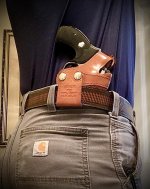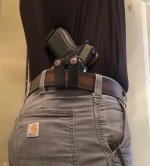Very slight cant forward for me is my preference but I do use a few non adjustable neutrals. I find the FBI cant (believe 15-25 degrees) can get a little to forward for me.
You are using an out of date browser. It may not display this or other websites correctly.
You should upgrade or use an alternative browser.
You should upgrade or use an alternative browser.
Straight Drop vs. FBI Cant
- Thread starter Whit
- Start date
In the car seated the canted holster is more comfortable. My opinion.
rednichols
Member
- Joined
- Jul 24, 2012
- Messages
- 2,745
- Reaction score
- 8,504
Lots of good answers there that are very near the mark. Yes, it depends -- but not so much on the pistol but on the 'clocking' of it around the waistbelt, in a holster.
Put your favorite pistol, or any pistol, in your waistband without a holster starting at 3:00. For your hand to insert the pistol into the trousers band naturally, you'll discover that the barrel is pointed roughly straight down. This w/b call zero 'caster'.
Move it 'round to 4:00 and you'll find that the angle has changed; this is about 25 degrees negative caster and the barrel is to the rear. This was used by the Texas Rangers beginning 1905 to conceal their SAAs in the Sunday scabbard better known as the Brill.
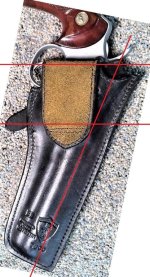
The FBI followed the same practice because both groups of gunfighters were required to hide their big guns well back of open coats. These were no longer cowboys. It's not an accident for another reaon, that the FBI and the Rangers used the same angle; they also used the same holsters. Famed Rangers like Trimble carried the Brill, and famed FBI agents like Bryce and Campbell carried the Myres Threepersons with the same angle.
Move the pistol further back towards the spine and you'll end up with a 60 degree angle while you're holding the pistol by its grips; this we call *** ("small of back carry" in censored mode) today.
Move it forward of 3:00, to 2:00, and the muzzle will begin to swing forward to what's known as positive caster; your hand will always fall naturally to the grip. This is the angle that became popular with 'combat' shooters of the '70s because it could also be used as a crossdraw on the opposite side.
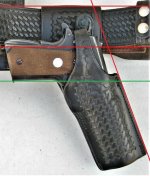
1:00 and 12:00 carry is simply stupid so it doesn't matter how well the hand falls to the grip when you shoot yourself
Anyway, because few makers accurately depict on their sites or catalogs, just how each of their holster models carries at an angle, one needs to be VERY careful in making a choice. Making assumptions about this purchase will create a 'box o holsters' for you. Ditto getting the carry HEIGHT wrong; ideally the holster carries your pistol with the knuckle of the second finger just clearing or touching your carry belt when concealed carry.
This height will keep your pistol from being top heavy, and keep the cylinder of a revolver at an ideal location on your torso. This is for concealed of course; specialized carry or cowboy carry has another set of 'rules'/'guidelines'.
This way the choice stops being a 'matter of opinion' but a matter of informed choice instead.
P.S. no pistol carrier you meet will truly know what angle his/her pistol is being carried at. I've been on forums a long time and typically these are simply educated guesses. i will say two things: the first is that one cannot 'feel' a difference in angle of 5 degrees; and the second is that no matter what angle you've been handed, you will move the grip along the belt line until your hand falls naturally to the grip ANWAY.
Put your favorite pistol, or any pistol, in your waistband without a holster starting at 3:00. For your hand to insert the pistol into the trousers band naturally, you'll discover that the barrel is pointed roughly straight down. This w/b call zero 'caster'.
Move it 'round to 4:00 and you'll find that the angle has changed; this is about 25 degrees negative caster and the barrel is to the rear. This was used by the Texas Rangers beginning 1905 to conceal their SAAs in the Sunday scabbard better known as the Brill.

The FBI followed the same practice because both groups of gunfighters were required to hide their big guns well back of open coats. These were no longer cowboys. It's not an accident for another reaon, that the FBI and the Rangers used the same angle; they also used the same holsters. Famed Rangers like Trimble carried the Brill, and famed FBI agents like Bryce and Campbell carried the Myres Threepersons with the same angle.
Move the pistol further back towards the spine and you'll end up with a 60 degree angle while you're holding the pistol by its grips; this we call *** ("small of back carry" in censored mode) today.
Move it forward of 3:00, to 2:00, and the muzzle will begin to swing forward to what's known as positive caster; your hand will always fall naturally to the grip. This is the angle that became popular with 'combat' shooters of the '70s because it could also be used as a crossdraw on the opposite side.

1:00 and 12:00 carry is simply stupid so it doesn't matter how well the hand falls to the grip when you shoot yourself
Anyway, because few makers accurately depict on their sites or catalogs, just how each of their holster models carries at an angle, one needs to be VERY careful in making a choice. Making assumptions about this purchase will create a 'box o holsters' for you. Ditto getting the carry HEIGHT wrong; ideally the holster carries your pistol with the knuckle of the second finger just clearing or touching your carry belt when concealed carry.
This height will keep your pistol from being top heavy, and keep the cylinder of a revolver at an ideal location on your torso. This is for concealed of course; specialized carry or cowboy carry has another set of 'rules'/'guidelines'.
This way the choice stops being a 'matter of opinion' but a matter of informed choice instead.
P.S. no pistol carrier you meet will truly know what angle his/her pistol is being carried at. I've been on forums a long time and typically these are simply educated guesses. i will say two things: the first is that one cannot 'feel' a difference in angle of 5 degrees; and the second is that no matter what angle you've been handed, you will move the grip along the belt line until your hand falls naturally to the grip ANWAY.
Last edited:
I only wear OWB holsters, preferably pancake holsters for CCW. They're all straight, no cant. Years ago when I carried a 6" 28-2, I bought an A. E. Nelson forward cant break-front duty holster (when they were authorized), opposite of the FBI cant and man, I could draw fast with that thing... Not as comfortable as the FBI cant in the car but since I was working a freeway beat it was the way to go for me...
OLDSTER
Member
rednichols
Member
- Joined
- Jul 24, 2012
- Messages
- 2,745
- Reaction score
- 8,504
Very slight cant forward for me is my preference but I do use a few non adjustable neutrals. I find the FBI cant (believe 15-25 degrees) can get a little to forward for me.
We can think of the FBI angle as originating with future FBI agents Jelly Bryce and Jerry Campbell, fellow detectives at Oklahoma City P.D. since 1927 who were recruited by Hoover for their reps for killing armed crims; both became agents for the BOI in 1934 that became the FBI in 1935. Both men had the Myres 614, as did agent Walsh; and we have two of the three of these men's holsters and can say confidently that 'the FBI angle' was that of the Brills of 1905 -- typically a carry angle of 30-35 degrees. That's a LONG way from 15-25 degrees. This is Walsh's, the other two agents are the same and first were for Smith's .44s then for the new .357s:
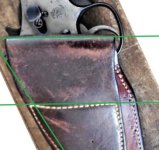
Also be aware that these agents favored the Myres over the Brill because the Myres belt loops were for wider gunbelts of 2+", and these agents liked to rock the holstered revolver forward during the draw; which I call the 'sling draw'. Many images of both men in action, and news articles about their Myres features.
Now: today's FBI may be using a Safariland plastic paddle holster that most definitely is nearly vertical, and it appears to be worn as on TV, forward of the hip (pelvis). So that angle is much less and c/b considered a 'modern' FBI angle yet darned near 100 years later . . ..
Last edited:
Alk8944
US Veteran
Is there a marked difference between the way straight drop and FBI cant holsters carry? Is there an advantage to one over the other, specifically when using for concealment? Is one more versatile than the other?
The "FBI Cant" was/is intended to facilitate the draw from a holster typically carried at waist level. It was not intended to improve either comfort when seated in/driving a car or concealment as others have opined. However, there may/can be some incidental benefit in either of these things.
Last edited:
walkin' trails
Member
- Joined
- Dec 16, 2006
- Messages
- 1,362
- Reaction score
- 802
I've used both. I would give a slight to the neutral (straight) cant for faster draw for most handguns. The FBI cant conceals better when carrying larger handguns, particularly larger grips. Bending with a neutral cant is going to print more.
Posted above..... see RedNichole's post 23 above...........
For most of the past 30 + years I've carried predominantly slight cant when carrying a S&W 3913NL IWB at 4 O'clock.
Lately, with cooler weather, I've been carrying a Beretta 92 Compact w/ 15rd Mec-gar magazine OWB in a Bang Bang Gun Leather "Rhodesian" w/ Stright drop at 3 O'clock Under a LL Bean "Hurricane" heavy cotton/fleece lined shirt.
The 92 Compact is really a "small' duty size gun IMO...... but the short butt on the Compact does not extend beyond my rib cage.
For most of the past 30 + years I've carried predominantly slight cant when carrying a S&W 3913NL IWB at 4 O'clock.
Lately, with cooler weather, I've been carrying a Beretta 92 Compact w/ 15rd Mec-gar magazine OWB in a Bang Bang Gun Leather "Rhodesian" w/ Stright drop at 3 O'clock Under a LL Bean "Hurricane" heavy cotton/fleece lined shirt.
The 92 Compact is really a "small' duty size gun IMO...... but the short butt on the Compact does not extend beyond my rib cage.
LoboGunLeather
US Veteran
Every holster design involves compromises among the 4 basic factors of comfort, accessibility, security, and concealment. When any one factor is emphasized there will be compromises in the other factors.
There is no such thing as the perfect holster any more than there is a perfect handgun for every user or situation.
What works well for one person will fail miserably for another person.
With holster cant as a specific topic for conversation, we need to consider the basic abilities and limitations of the human body. Neutral cant works very well when carried on the point of the hip (3 o'clock position) or slightly forward. A butt-forward cant works well when carried behind the hip. The further to the rear a holster is carried the more cant is required to allow the hand, wrist, and forearm to achieve a correct shooting grip when drawing the weapon.
Forcing the hand and wrist to rotate to extreme positions has a negative effect on grip strength. What good is it to draw your weapon without having positive control? What good is it to draw your weapon, then have to shift your grip before you are able to properly address a potential target?
For most civilian concealed carry (and plain clothes LE work) a strong-side holster riding just behind the hip (3:30 to 4:00 position) with about 15-degrees forward cant provides the optimum combination of comfort, concealment, and accessibility. Security can be addressed by retention devices (thumb-break), but is also possible simply by clamping your strong-side arm snugly against the body.
Again, nothing is perfect, nothing is absolute, and nothing is fool-proof. Only the individual user can determine which factors are most important for his circumstances and choose accordingly (knowing that compromises are part of the selection process).
There is no such thing as the perfect holster any more than there is a perfect handgun for every user or situation.
What works well for one person will fail miserably for another person.
With holster cant as a specific topic for conversation, we need to consider the basic abilities and limitations of the human body. Neutral cant works very well when carried on the point of the hip (3 o'clock position) or slightly forward. A butt-forward cant works well when carried behind the hip. The further to the rear a holster is carried the more cant is required to allow the hand, wrist, and forearm to achieve a correct shooting grip when drawing the weapon.
Forcing the hand and wrist to rotate to extreme positions has a negative effect on grip strength. What good is it to draw your weapon without having positive control? What good is it to draw your weapon, then have to shift your grip before you are able to properly address a potential target?
For most civilian concealed carry (and plain clothes LE work) a strong-side holster riding just behind the hip (3:30 to 4:00 position) with about 15-degrees forward cant provides the optimum combination of comfort, concealment, and accessibility. Security can be addressed by retention devices (thumb-break), but is also possible simply by clamping your strong-side arm snugly against the body.
Again, nothing is perfect, nothing is absolute, and nothing is fool-proof. Only the individual user can determine which factors are most important for his circumstances and choose accordingly (knowing that compromises are part of the selection process).
.........
For most civilian concealed carry (and plain clothes LE work) a strong-side holster riding just behind the hip (3:30 to 4:00 position) with about 15-degrees forward cant provides the optimum combination of comfort, concealment, and accessibility. Security can be addressed by retention devices (thumb-break), but is also possible simply by clamping your strong-side arm snugly against the body...
^This.
Well said.
Plus, I'd add that I've purchased many a holster that I thought would be perfect, but after wearing them for a week, I wasn't comfortable.
How far up or down the pistol rides also matters.
I only wear inside the pants.
Just FYI, this is how I wear my 3" model 66. I don't even know it's there.
Just for giggles, this is how I wear an autoloader (Glock23).
Attachments
Last edited:
Similar threads
- Replies
- 2
- Views
- 822
- Replies
- 11
- Views
- 896
- Replies
- 25
- Views
- 2K
- Replies
- 23
- Views
- 2K
- Locked
- Replies
- 1
- Views
- 539


